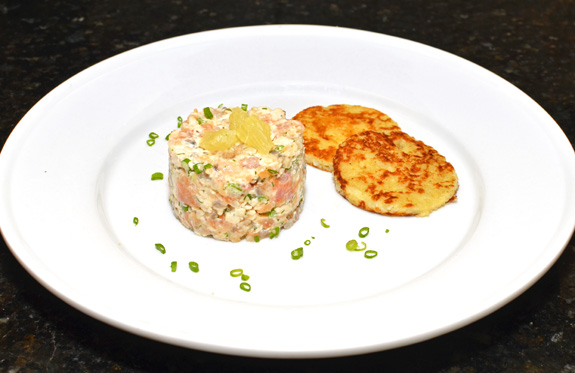The idea for this recipe came to me last weekend, when I went hunting for wild turkey, and came home with three brook trout. The spring turkey hunt with Wayne was rather tricky this year: the gobblers didn’t gobble, and the ones we saw didn’t show much interest in our languorous hen calls. Having read an article in New York Game and Fish about trout fishing in Ninemile Creek, I decided to try my luck there while I was in the area. What I didn’t know is that Wayne happens to be friends with one Mike Kelly, who A) wrote the article I read, B) has been fishing Ninemile Creek for most of his life, and C) was generous enough to spend his Saturday afternoon showing me around with his friend Paul, despite having already hunted turkey and caught his limit of trout earlier the same day!
So, while I wasn’t completely successful in my little cast-and-blast trip, I thought it would still be interesting to create a Syracusan sportsman’s perfect May appetizer, a recipe that would highlight the delicate flavors of both trout and turkey, and at the same time showcase some spring produce.
I can already imagine some readers gesticulating in indignation:
- Complaint #1: “Do you really expect me to get up at 3:30 in the morning, kill a wild turkey, then go fish some brook trout? All to make a tiny tartare using one of those fussy ring molds of yours?”
Response: If you’re not into killing your own food, feel free to buy a good chicken and a rainbow trout instead. They may not bring the same satisfaction, but they’ll certainly make a very good dish. The ring mold is optional; you can use your hands (but it won’t look as nice). - Complaint #2: “My grandmother is from Eastern Europe and she never made a tartare with wild turkey and brook trout. Where exactly did you see wild turkeys in Eastern Europe? Why can’t you blog about goulash and pierogies like a normal person?”
Response: There may not be any wild turkeys in Eastern Europe, but chickens, pheasants, and partridges are plentiful. So are trout. It also seems to me that dill, chives, sour cream, and mushrooms are rather typical of Eastern European cuisine, and so is the habit of cutting food into tiny pieces. In fact, I’ve posted examples of tartares from Russia, Poland and East Germany. Oh, and I’ve already blogged about goulash and pierogies.
You can serve the tartare with toasted rye bread or deruny.
Wild turkey and brook trout tartare
Yields 2 servings
3.5 oz skinned wild turkey breast
2 oz white mushrooms
0.3 oz ramps (white part only)
1 oz light olive oil
salt
4.5 oz cleaned (boned and skinned) brook trout flesh
1 tsp (1.8 g) finely chopped chives
3/8 tsp (0.8 g) finely chopped dill
1 oz sour cream
2 lemon segments, membrane removed
- Cut the turkey breast, mushrooms, and ramps into a brunoise. Heat the olive oil in a pan over high heat, then add the turkey. Season with salt, and sear for a minute, stirring constantly. Add the mushrooms and ramps, and cook over medium heat until just done, still stirring regularly. Don’t overcook; you just need the meat to be white inside and the vegetables to be soft. Let cool to room temperature.
- Cut the trout into a brunoise, and place into a blow with the chopped chives and dill, and the sour cream. Add the turkey mixture, and mix thoroughly with a spatula. Cover and refrigerate.
- Take out from the refrigerator 15 minutes before serving. Shape the tartare using a 2.5″ diameter ring mold, and top each portion with a lemon segment cut into 3 pieces.



1 comment
[…] about my turkey hunts with Wayne a few times. There was the spring gobbler I killed last year, and the hunt-turned-fishing trip last May. All in all, I’ve known him for about 3 years, and was planning a couple of fishing and […]